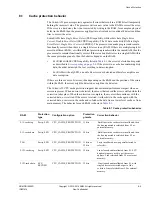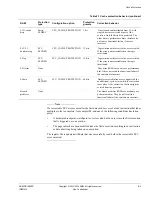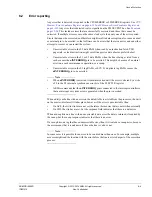
Generic Timer
ARM DDI 0500D
Copyright © 2013-2014 ARM. All rights reserved.
10-3
ID021414
Non-Confidential
10.2
Generic Timer functional description
The Cortex-A53 processor provides a set of timer registers within each core of the cluster. The
timers are:
•
An EL1 Non-secure physical timer.
•
An EL1 Secure physical timer.
•
An EL2 physical timer.
•
A virtual timer.
The Cortex-A53 processor does not include the system counter. This resides in the SoC. The
system counter value is distributed to the Cortex-A53 processor with a synchronous binary
encoded 64-bit bus,
CNTVALUEB[63:0]
.
Because
CNTVALUEB
is generated from a system counter that typically operates at a slower
frequency than the main processor
CLKIN
, the
CNTCLKEN
input is provided as a clock
enable for the
CNTVALUEB
bus.
CNTCLKEN
is registered inside the Cortex-A53 processor
before being used as a clock enable for the
CNTVALUEB[63:0]
registers. This allows a
multicycle path to be applied to the
CNTVALUEB[63:0]
bus.
Figure 10-1
shows the interface.
Figure 10-1 Architectural counter interface
The value on the
CNTVALUEB[63:0]
bus is required to be stable whenever the internally
registered version of the
CNTCLKEN
clock enable is asserted.
CNTCLKEN
must be
synchronous and balanced with
CLK
and must toggle at integer ratios of the processor
CLK
.
See
Clocks
on page 2-9
for more information about
CNTCLKEN
.
Each timer provides an active-LOW interrupt output to the SoC.
Table 10-1
shows the signals that are the external interrupt output pins.
Cortex-A53 processor
Clock gate
CNTCLKEN
register
Architectural
counter
registers
CNTVALUEB[63:0]
CNTCLKEN
Table 10-1 Generic Timer signals
Signal
a
a.
n
is the number of cores present in the cluster, minus one.
Description
nCNTPNSIRQ[n:0]
EL1 Non-secure physical timer event
nCNTPSIRQ[n:0]
EL1 Secure physical timer event
nCNTHPIRQ[n:0]
EL2 physical timer event
nCNTVIRQ[n:0]
Virtual timer event
















































